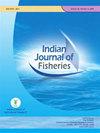Spatial distribution of fishing intensity of canvas stow net fishing vessels in the East China Sea and the Yellow Sea
IF 0.3
4区 农林科学
Q4 FISHERIES
引用次数: 1
Abstract
Present study used the position data of BeiDou Vessel Monitoring System (VMS) in 2018, with respect to motorised fishingvessels in the East China Sea and the Yellow Sea to construct a fishing vessel operating status classification model based onthreshold, deep neural network and DBSCAN density clustering algorithm. The geographic grid was divided into cells of0.1°×0.1° and the average fishing time per square km (h km-2) in each grid was calculated to obtain the spatial distributionof fishing intensity in the study region in 2018. The results showed that the threshold method could classify fishing vesselsailing, anchoring and other states with an accuracy of more than 95%. The deep neural network and DBSCAN algorithmcould classify the two states of netting and closing with an accuracy of 94.7%. By classifying the status of fishing vessels,quantitative monitoring can be carried out to better serve the management of marine fishery resources and marine ecologicalprotectionKeywords: China, DBSCAN, Deep neural network, Fishing intensity, Spatial distribution, VMS, Voyage extraction东海、黄海帆布拖网渔船捕捞强度的空间分布
本研究利用2018年北斗船舶监测系统(VMS)对东海和黄海机动渔船的位置数据,构建了基于阈值、深度神经网络和DBSCAN密度聚类算法的渔船作业状态分类模型。将地理网格划分为0.1°×0.1°的单元格,计算每个单元格内每平方公里平均捕捞时间(h km-2),得到研究区2018年捕捞强度的空间分布。结果表明,阈值法可以对渔船航行、锚泊等状态进行分类,准确率在95%以上。采用深度神经网络和DBSCAN算法对两种状态进行分类,准确率达94.7%。通过对渔船状态进行分类,可以进行定量监测,更好地为海洋渔业资源管理和海洋生态保护服务。关键词:中国,DBSCAN,深度神经网络,捕捞强度,空间分布,VMS,航次提取
本文章由计算机程序翻译,如有差异,请以英文原文为准。
求助全文
约1分钟内获得全文
求助全文
来源期刊

Indian Journal of Fisheries
FISHERIES-
CiteScore
0.90
自引率
20.00%
发文量
0
审稿时长
6-12 weeks
期刊介绍:
Indian Journal of Fisheries is published quarterly by the Indian Council of Agricultural Research (ICAR), New Delhi. Original contributions in the field of Fish and fisheries science are considered for publication in the Journal. The material submitted must be unpublished and not under consideration for publication elsewhere.
Papers based on research which kills or damages any species, regarded as thratened/ endangered by IUCN crieteria or is as such listed in the Red Data Book appropriate to the geographic area concerned, will not be accepted by the Journal, unless the work has clear conservation objectives.
 求助内容:
求助内容: 应助结果提醒方式:
应助结果提醒方式:


